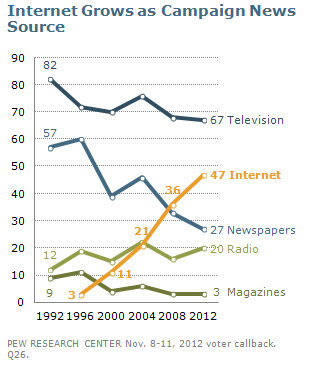Pew survey says TV still tops for election news
The Pew Research Center is out with its post-election look at the attitudes of voters about the elections, the campaigns and the media, and once again television ranks No. 1 as the source of news and information about the presidential race.
Not only is the percentage of voters who named TV as the main source of news during the campaign the highest among all media (67 percent), including the Internet, newspapers, radio and magazines, but it also among voters who watched the returns on election night television news led the pack at 92 percent.
A more granular look at television news reveals 42 percent of voters identified cable news as their main source, followed by network television news at 19 percent and local TV news at 11 percent, the Pew study found. The percentages have not changed much since 2008. In 2004, 76 percent identified TV as their main source of election news.

Among the three major cable news outlets, Fox News Channel topped the list as voters’ main news source with 23 percent, followed by CNN at 18 percent and MSNBC at 9 percent, which is similar to the breakdown from the 2008 presidential sweepstakes, Pew said.
More voters also are turning to the Internet for news about the presidential campaign, the study revealed. Forty-seven percent cited the Internet as their main source of campaign news. (Respondents were able to identify more than one news outlet as their main source.) Four years ago, 36 percent identified the Internet as their top source. The Internet now surpasses newspapers as being the main source of campaign news, Pew said.
“Dual screening” played a role in tracking election night returns, the study found. A total of 27 percent used both TV and the Internet to get information, the study found. Voters younger than 40 were more likely to dual screen as 39 percent of the group turned to TV and the Internet, Pew said.
Education also played a factor in the use of dual screens. College graduates (36 percent) and those with some college education (28 percent) were more likely to track the returns on TV and the Internet than those with no more than a high school education (14 percent.)
The professional video industry's #1 source for news, trends and product and tech information. Sign up below.
The research also revealed voters generally were displeased with how the press covered the campaign. Only 32 percent of voters said they would give the press an “A” or “B” grade for how it conducted itself during the campaign. Among Republicans, just 19 percent would award an “A” or “B;” similarly, for independents the figure stood at 21 percent. Among Democrats, however, 52 percent gave the press a positive rating.
The findings, released Nov. 15, are based on a telephone (landline and cell phone) survey of 1206 voters conducted Nov. 8-11. Interviews were conducted among registered voters, age 18 and older. The margin of error among all voters was +/-3.4 percentage points.
